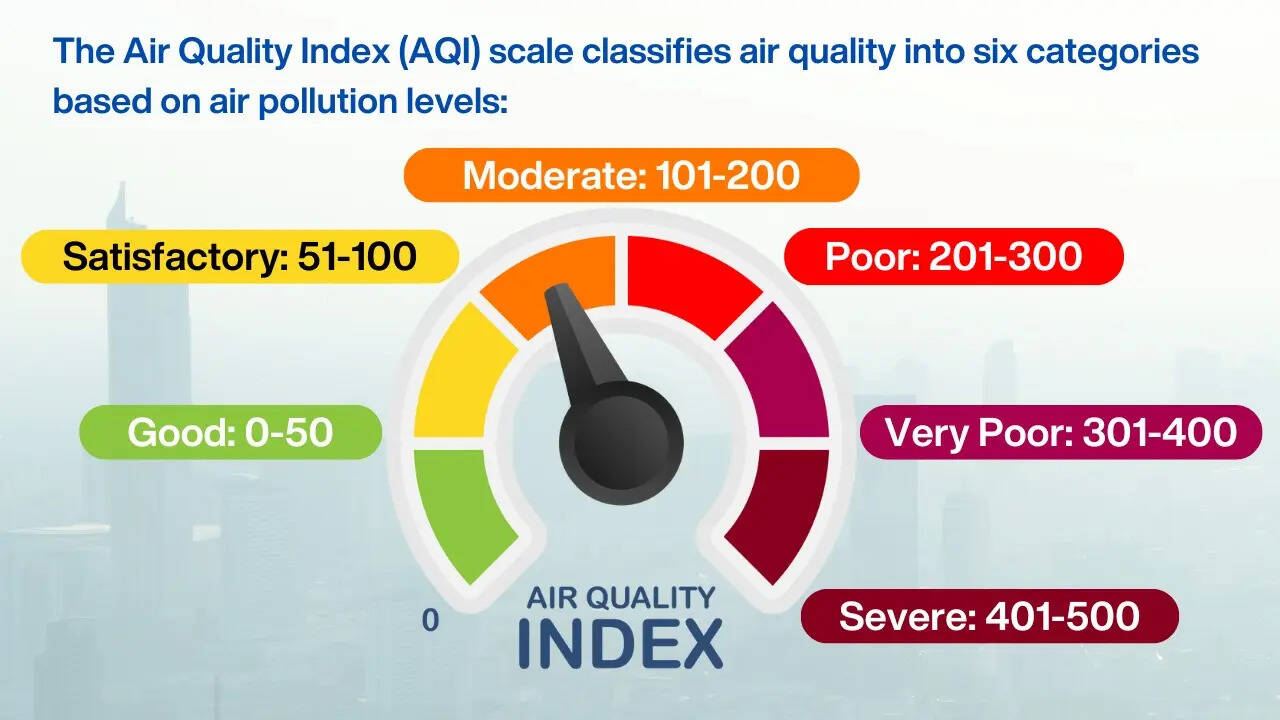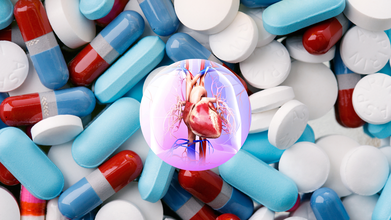- Health Conditions A-Z
- Health & Wellness
- Nutrition
- Fitness
- Health News
- Ayurveda
- Videos
- Medicine A-Z
- Parenting
- Web Stories
Delhi Pollution Is Causing Health Issues Not Seen Before

The air quality index (AQI) has worsened in Delhi-NCR in the past few days with the Commission for Air Quality Management (CAQM) invoking stage two of the anti-pollution plan Graded Response Action Plan (GRAP). Doctors and experts have also taken note of the rise in pollution, and have observed diseases they have not seen before.
Dr Sanjay Jain, a Delhi-based ENT and a member of DocTube also noted an increase in the number of patients with respiratory issues. "I have seen a notable increase in patients with upper respiratory tract infections, chronic sinusitis, and allergic rhinitis, which are directly linked to rising pollution levels," he says. From his experience, he has noticed a rough increase of 30 to 40% of patients with pollution-related ENT issues.
What Is The Administration Doing?
As per the System of Air Quality and Weather Forecasting and Research (SAFAR), the AQI in Delhi at 8 am today was recorded at 317, which falls under the "very poor" category. The India Meteorological Department (IMD) has predicted that the average AQI will stay in the "very poor" category in the coming days.

GRAP accounts for the restrictions on the usage of coal and firewood, and diesel generator sets in the Delhi-NCR. Furthermore, plans for mechanical sweeping and water sprinkling on the identified roads will also be carried on a daily basis. The plan expands to dust control measures at the construction and demolition sites too.
Parking fees will also be increased to discourage private transport with additional buses and metro services to start soon.
Source Of Pollution
A study titled What Is Polluting Delhi's Air? A Review from 1990 to 2022 mentions that Delhi's major contributor is road transport, while the second major factor comes from burning agricultural waste or stubble. Other factors like waste management, the construction sector, roads, and firecrackers during Diwali also lead to the increase in pollution.
Health Issues
Delhi pollution is more dangerous than we think. Not just breathing issues, but it can also lead to lung cancer and heart diseases. Studies have shown that prolonged exposure to pollution can lead to a reduction in lung function and also premature death, especially in children. It can also lead to increased risks of stroke, cognitive decline, and even pregnancy complications.
Doctors also take note of other pollution-related issues that were not seen before or are unusual. Dr Jain says that prolonged exposure to pollution can cause chronic ear infections in children due to inflammation in the Eustachian tube. "This is not commonly recognised by the people," he says. Dr Brunda MS, senior consultant, of internal medicine at Aster CMI Hospital in Bengaluru also explains that many people remain unaware of the health issues associated with pollution. Apart from shortness of breath, environmental toxins can cause brain diseases and reproductive health issues. "The subtle and slow effects of pollution often lead Understanding these relationships can help communities promote cleaner, more resilient environments," explains the doctor.
The doctor also explains the impact of pollution on the eyes as it can cause conjunctivitis or worsen any pre-existing eye infection. Dr Brunda MS also mentions that air pollution is responsible for 1.67 million deaths in India, which is 17.8% of the total deaths in the country. "There has been a 3 to 4% increase in a number of cases because of pollution," the doctor explains.
How To Stay Safe?
Dr Jain explains the precautions one can take to stay safe and prevent these diseases from happening. "Individuals can protect themselves by wearing masks, using air purifiers at home, avoiding outdoor activities during high-pollution days, and maintaining a healthy lifestyle," he explains.
The doctors also recommend wearing N95 masks, surgical masks or equivalent for effective filtration of airborne particles, consuming warm fluids and herbal teas and eating food rich in vitamin C and antioxidants that will help reduce inflammation and protect mucous membranes in the throat.
Five Every Day Drugs That Could Negatively Impact Your Heart, According To Doctor

Credits: Canva
Every medicine has its own set of side effects, and Dr Dmitry Yaranov, a Russia-based cardiologist, who specializes in heart failure, advanced heart failure, heart transplantation, and mechanical circulatory support, says that some everyday drugs can pose hidden risks to the heart. His message is not meant to spark fear but to encourage awareness about medications we often assume are completely harmless.
Below are five categories of common drugs that Dr. Yaranov believes deserve more caution, especially for those with existing heart issues.
NSAIDs - Nonsteroidal Anti-inflammatory Drugs
These are your everyday painkillers, which includes ibuprofen or naproxen. While they are go-to options for headaches, fever, or muscle cramps, Dr Yaranov says that its frequent use could strain the heart.
These drugs reduce inflammation by blocking certain chemical pathways, but they also make the body retain salt and water. This can:
- Raise blood pressure
- Worsen swelling
- Increase the risk of heart failure, particularly in people who already have high blood pressure or heart disease
Dr. Yaranov suggests discussing long-term or frequent NSAID use with a doctor, instead of using them casually.
Chemotherapy Drugs
While these drugs are life-saving, it may have side effects that could weaken the heart muscles. Dr Yaranov explains that drugs like doxorubicin or trastuzumab could also affect how well the heart pumps blood, which can lead to ardiomyopathy or heart failure.
Because of this, many cancer centres now include routine heart monitoring before, during, and after chemotherapy. The goal is to fight cancer without compromising long-term heart health.
Stimulant Medicines For ADHD
Stimulants that contain amphetamines help improve focus and alertness, but Dr. Yaranov warns that they can also:
- Increase heart rate
- Raise blood pressure
- Trigger arrhythmias
Elevate the risk of heart attack in people who have underlying heart issues
He stresses that misuse or unsupervised use is especially dangerous. Even for those who take them as prescribed, regular follow-ups with a doctor are important.
Older Diabetes Medications
Managing diabetes could mean being on medicines for lifelong. Yaranov points out that older drugs like rosiglitazone can increase the risk of heart failure despite effectively lowering blood sugar. Because of these concerns, many doctors now prefer newer diabetes medications that also support cardiovascular health. However, patients should never switch or stop medicines without medical guidance.
Common Cold Medicines
Thanks to allergens and climate change, common cold now stays all around the year, which means you will be taking cold medicines frequently and for a longer stretch. These medicines contain pseudoephedrine that work by narrowing blood vessels to relieve nasal congestion, however, Dr Yaranov says that they can also:
- spike blood pressure
- Disturb normal heart rhythms
- Increase strain on the heart
For individuals with hypertension or heart disease, Dr. Yaranov advises avoiding these drugs or using them only after consulting a healthcare provider.
Dr. Yaranov’s core message is simple: even routine medications have side effects worth understanding. Being informed helps people protect their cardiovascular health, especially if they already have heart risk factors. The goal is not to avoid necessary treatment but to use medicines wisely and stay in regular touch with your doctor.
Note: This article is based purely on the remarks shared by Dr. Dmitry Yaranov. Health and Me does not recommend discontinuing or changing any medication without first consulting your doctor.
TrumpRx Deal For Lowering Popular Weight Loss Drugs Is Not Flawless, People May End Up Paying More, Say Experts

Credits: AP
"Did I do a good job? Do you think Biden could have done this? I don't think so," said President Donald Trump to the reporters assembled at the Oval Office after he made the announcement that he had secured a deal to slash the price of obesity drugs. His website, TrumpRx, will offer the sale of drugs like Wegovy and Zepbound, for only around $250 a month, which is a fraction of their current retail price which is more than $1,000.
While it is a breakthrough, as many private insurances do not cover obesity drugs, and often forces people to pay for these injections out of pocket, experts point out that this system is not entirely flawless.
TrumpRx Is Not Flawless
Drug policy experts say that while the administration has promised drugs at a cheaper rate, some of these discounts have not been approved yet by the Food and Drug Administration. The problem is that the lower prices for people paying out of pocket would only apply to the lowest doses of the drugs, however, the deal does not expand Medicare coverage to people seeking treatment for weight loss alone.
Juliette Cubanski, who is the deputy director of Medicare policy program at KFF, said, and as is reported in NBC News, "It’s a situation where we have more questions than answers. Based on what we didn’t hear, that suggests to me that there’s a lot that the administration itself hasn’t even ironed out as of yet. It just feels a little bit too squishy right now."
Art Caplan, also reported in NBC News, who is the head of the division of medical ethics at NYU Grossman School of Medicine in New York City, said, "It’s just murky as to how this will take shape, how the programs will work. You can’t really tell from what’s going on.”
Are There Unapproved Drugs On The List?
Several drugs and forms of drugs included in the deal are actually not approved by the FDA. These include oral versions of weight loss drugs, and Eli Lilly's new multidose injection pens. In fact, Lawrence Gostin, director of the O'Neill Institute for National and Global Health Law at Georgetown University said that the administration has made premature promises because the lower prices cannot take effect until the products are on the market. "It is reckless to negotiate pricing deals on products which the FDA have not yet approved as safe and effective. The administration is getting way out ahead of its own safety agency.”
The list includes:
- Oral weight loss pills by Wegovy
- Oral weight loss pills by Novo Nordisk
- Multidose version of Zepbound
Prices Are Low, But People May End Up Paying More
While the White House did say that both the pills and injection pens will be available for discounted prices for those who pay out of pocket, policy makers say that they may end up paying more.
The starting doses of weight loss pill will cost $149 per month, and the shots will cost around $350 for a month's supply. The price of the injection is further expected to fall to about $259 within two years. However, when people start with the drugs, they start with the lowest dose that allows the body to get used to the drug, However, over the course of time, the dose increases to be effective for weight loss. For Wegovy, the highest doses are five, for Zepbound, it is six, and the most weight loss has seen with the highest doses.
Officials said the starting dose of GLP-1 pills will cost $149 per month, though they didn’t clarify pricing for higher doses.
For injections, the White House offered only a “weighted average” estimate of $350 a month. Lilly later specified that Zepbound will start at $299 for the lowest dose, rising to $449 for higher ones. Novo Nordisk didn’t confirm dose-based pricing and said it will share updated cost details in the coming weeks.
All of this means patients using TrumpRx could ultimately pay significantly more than the administration’s headline prices, especially since most people don’t remain on the lowest dose for long, Caplan noted.
Davina McCall Reveals Breast Cancer Surgery A Year After Her Brain Tumor Surgery

Credits: Wikimedia Commons
TV presenter Davina McCall revealed that she had breast cancer, almost a year after she had undergone a surgery to remove her brain tumor. In a video that she posted on her Instagram, she revealed that she was "very angry" when she found out the news, however, she is in a "much more positive place" after she has undergone another surgery three weeks ago to remove the tumor from her breast.
How Did She Realize She Had Breast Cancer?
She said that she found a lump a few weeks ago, however, it came and went back, so she continued to do her work. "I found a lump a few weeks ago. It came and went but then I was working on The Masked Singer and Lorraine, the TV show, and Lorraine Kelly had put signs on the backs of all the doors saying 'check your breasts' and every time I went for a wee, I did that," she said.
She continued: "It was still there, and then one morning I saw myself in the mirror and thought 'I'm going to get that looked at'. I had a biopsy. I found out it was indeed breast cancer and I had it taken out in a lumpectomy nearly three weeks ago."
McCall, who is now 58, says that the lump was "very, very small" and was discovered at an early stage. "I am so relieved to have had it removed and to know that it hasn't spread. My lymph nodes were clear, I didn't have any removed, and all I'm going to do now is have five days of radiotherapy in January as kind of an insurance policy," she said.
"It's been a lot. I was very angry when I found out, but I let go of that, and I feel in a much more positive place now. "I think my message is: get checked if you're worried. Check yourself regularly. If you are due a mammogram, then get it done," she said.
Dense Breast And Mammogram
She also revealed that it was only in August that she got her mammogram done, however, she has dense breasts, and so nothing was detected. "I have dense breasts and I had a mammogram in August, and I was postponing the ultrasound; I just couldn't find time to do it. Don't do that. Get the ultrasound."
Difference Between Breast Ultrasound And A Mammogram
Breast Ultrasound: A breast ultrasound uses sound waves that reflect off the breast tissue to create detailed images of the breast. There is no radiation involved.
Mammogram: A mammogram is an X-ray of the breast. A mammogram is an X-ray of the breast. A diagnostic mammogram focuses more closely on the area(s) of concern. We will get more X-ray views of the concerning area. We perform a diagnostic mammogram any time a patient comes in with symptoms of breast cancer or after an abnormal screening mammogram.
As per the MD Anderson Cancer Center, normal breast tissue and cancerous tissue, both appear white on a mammogram, this is when an ultrasound can help us see small cancers that may be hiding amongst normal breast tissue. This is especially true for women with dense breasts, which means they have more glandular tissue and less fat in their breasts.
However, the MD Anderson Cancer Center mentions that ultrasound is not recommended as a replacement for a mammogram. "Screening mammograms detect about 4 to 6 cases of breast cancer per 1,000 women. When a breast ultrasound is done on top of that, we detect about 2 to 3 more cases. So, breast ultrasound is a valuable screening tool we use in addition to a mammogram," it notes.
© 2024 Bennett, Coleman & Company Limited

